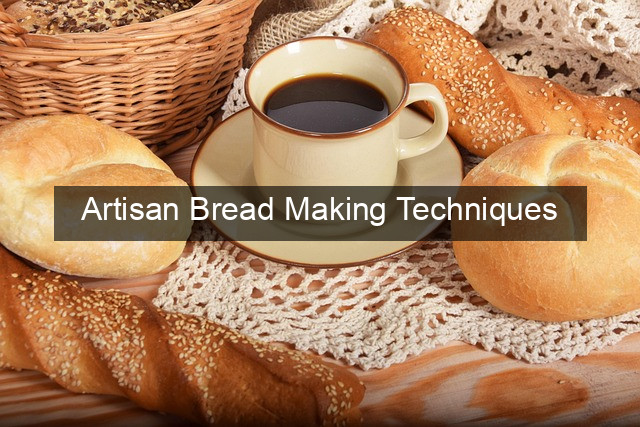Artisan Bread Making Techniques

- Artisan Bread Making Techniques
- Understanding the Fundamentals of Artisan Bread
- The Importance of Flour
- The Magic of Yeast
- The Role of Water
- Mastering Essential Artisan Bread Making Techniques
- Kneading: Developing Strength and Structure
- Fermentation: The Heart of Artisan Bread
- Shaping and Proofing: The Final Touches
- Baking and Beyond: Achieving Artisan Perfection
- Understanding Your Oven
- Scoring: The Art of Bread Slashing
- Cooling and Storage: Preserving Your Masterpiece
- Troubleshooting Common Artisan Bread Making Challenges
- Conclusion
- Frequently Asked Questions
- What is the difference between artisan bread and regular bread?
- How do I know if my sourdough starter is active?
- What is the best way to store artisan bread?
- Why is my bread dense and heavy?
- How do I achieve a crispy crust?
- Can I use all-purpose flour for artisan bread?

From rustic sourdoughs to crusty ciabatta, the world of artisan bread making beckons with the promise of flavorful, textured loaves. It’s a journey that transcends simple baking, delving into the science and art of fermentation, kneading, and shaping. This exploration of artisan bread making techniques will equip you with the knowledge and inspiration to create exceptional bread at home. Forget the store-bought loaves; prepare to embark on a sensory experience where the aroma of freshly baked bread fills your kitchen and the satisfaction of crafting something truly special fills your soul. Artisan bread making isn’t just about following a recipe; it’s about understanding the process, embracing the imperfections, and reveling in the unique character of each loaf. It’s a journey of discovery, where every bake is a learning experience, and every loaf is a testament to the time and care invested. So, roll up your sleeves, gather your ingredients, and prepare to unlock the secrets of artisan bread making.
Understanding the Fundamentals of Artisan Bread
The Importance of Flour
Flour is the foundation of any bread, and in artisan bread making, its quality is paramount. Different types of flour, such as bread flour, all-purpose flour, and whole wheat flour, contain varying levels of protein, which directly affects the gluten development and the final texture of the bread. Choosing the right flour for your desired outcome is the first step towards a successful bake.
Understanding the protein content and how it interacts with water and yeast is crucial for achieving the desired rise and crumb structure. Experimenting with different flour blends can also add complexity and nuance to your bread’s flavor and texture.
Beyond protein content, the origin and milling process of the flour can also impact the final product. Stone-ground flours, for instance, retain more of the grain’s nutrients and contribute a slightly coarser texture.
The Magic of Yeast
Yeast is the living organism responsible for leavening bread, giving it its characteristic rise and airy texture. In artisan bread making, the use of wild yeast or sourdough starter adds a depth of flavor and complexity that commercial yeast cannot replicate.
Cultivating and maintaining a sourdough starter requires patience and care, but the rewards are well worth the effort. The unique blend of microorganisms in a sourdough starter contributes to the bread’s distinct tangy flavor and improved digestibility.
Understanding the different types of yeast and how they behave is essential for controlling the fermentation process and achieving the desired results.
The Role of Water
Water is more than just a liquid ingredient in bread making; it’s the medium that activates the yeast and hydrates the flour, allowing gluten to develop. The temperature and quality of the water can significantly impact the fermentation process and the final product.
Using filtered or spring water can enhance the flavor of the bread, while ensuring the water temperature is optimal for yeast activity is crucial for a successful rise.
The amount of water used, expressed as baker’s percentage, determines the hydration level of the dough, influencing its texture and handling characteristics.
Mastering Essential Artisan Bread Making Techniques
Kneading: Developing Strength and Structure
Kneading is the process of working the dough to develop gluten, the protein network that gives bread its structure and elasticity. Proper kneading techniques are essential for achieving the desired texture and crumb structure.
Different methods of kneading, such as hand kneading and using a stand mixer, can be employed, but the goal remains the same: to develop a strong and elastic dough.
Understanding the signs of a well-kneaded dough, such as the windowpane test, is crucial for ensuring the bread has the proper structure and rise.
Fermentation: The Heart of Artisan Bread
Fermentation is the process by which yeast consumes sugars and produces carbon dioxide, causing the dough to rise. In artisan bread making, fermentation plays a critical role in developing flavor and texture.
Controlling the temperature and duration of fermentation is essential for achieving the desired flavor profile and crumb structure. Bulk fermentation, followed by shaping and proofing, allows the dough to develop complex flavors and a light, airy texture.
Understanding the different stages of fermentation and how they affect the final product is key to mastering artisan bread making.
Shaping and Proofing: The Final Touches
Shaping the dough is an art in itself, influencing the final shape and appearance of the loaf. Different shaping techniques, such as boule, baguette, and batard, create distinct forms and textures.
Proper shaping ensures even expansion during baking and contributes to the aesthetic appeal of the finished loaf.
After shaping, the dough undergoes a final proofing period, allowing it to rise one last time before baking.
Baking and Beyond: Achieving Artisan Perfection
Understanding Your Oven
The oven plays a crucial role in the final stage of bread making. Understanding your oven’s quirks and how to create the ideal baking environment is essential for achieving a perfectly baked loaf.
Using a baking stone or Dutch oven can help create a more consistent and even bake, resulting in a crispy crust and a well-developed crumb.
Monitoring the oven temperature and adjusting baking times as needed is crucial for achieving the desired results.
Scoring: The Art of Bread Slashing
Scoring the dough before baking allows for controlled expansion and creates decorative patterns on the crust. Different scoring techniques can influence the final shape and appearance of the loaf.
Practicing scoring techniques and understanding how they affect the baking process can elevate your bread making to an art form.
Beyond aesthetics, scoring also plays a functional role, preventing the crust from cracking and allowing the bread to expand fully during baking.
Cooling and Storage: Preserving Your Masterpiece
Proper cooling and storage techniques are essential for preserving the quality and freshness of your artisan bread. Allowing the bread to cool completely before slicing prevents a gummy texture and allows the flavors to fully develop.
Storing bread in a breadbox or airtight container can help maintain its freshness and prevent it from drying out.
Understanding the best practices for cooling and storing your bread will ensure you can enjoy your hard-earned creation for days to come.
Troubleshooting Common Artisan Bread Making Challenges
| Problem | Possible Cause | Solution |
|---|---|---|
| Dense crumb | Under-kneading, insufficient fermentation | Knead longer, increase fermentation time |
| Flat loaf | Over-proofing, too much yeast | Reduce proofing time, decrease yeast amount |
| Burnt crust | Oven temperature too high | Lower oven temperature, reduce baking time |
- Experiment with different flours and hydration levels.
- Practice kneading and shaping techniques.
- Observe your dough throughout the fermentation process.
Conclusion
The journey of artisan bread making is a rewarding one, filled with the satisfaction of creating something truly special with your own hands. From the careful selection of ingredients to the final cooling of the loaf, every step is an opportunity to learn and grow as a baker. Embracing the imperfections and celebrating the unique character of each loaf is part of the beauty of artisan bread making. While the process may require patience and practice, the rewards are immeasurable. The aroma of freshly baked bread filling your home, the satisfying crackle of a perfectly crisp crust, and the simple pleasure of sharing a homemade loaf with loved ones – these are the moments that make artisan bread making so worthwhile. So, continue to explore, experiment, and enjoy the journey of crafting exceptional bread.
Frequently Asked Questions
What is the difference between artisan bread and regular bread?
Artisan bread typically emphasizes traditional methods, longer fermentation times, and high-quality ingredients, resulting in a more complex flavor and texture.
How do I know if my sourdough starter is active?
An active starter will be bubbly and double in size after feeding.
What is the best way to store artisan bread?
Store cooled bread in a breadbox or airtight container at room temperature.
Why is my bread dense and heavy?
Possible causes include under-kneading, insufficient fermentation, or incorrect ingredient ratios.
How do I achieve a crispy crust?
Baking in a Dutch oven or using a baking stone with steam can help create a crispy crust.
Can I use all-purpose flour for artisan bread?
While all-purpose flour can be used, bread flour with higher protein content is generally preferred for better gluten development.



